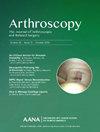Editorial Commentary: Trends in Hip Arthroscopy Require Rapid Dissemination From Higher-Volume and Academic Surgeons to the Greater Orthopaedic Community
IF 4.4
1区 医学
Q1 ORTHOPEDICS
Arthroscopy-The Journal of Arthroscopic and Related Surgery
Pub Date : 2024-10-01
DOI:10.1016/j.arthro.2024.02.029
引用次数: 0
Abstract
Trends in hip arthroscopy show that labral repair and preservation, capsular repair and preservation, and treatment of femoroacetabular impingement during hip arthroscopy are associated with superior short-term and mid- to longer-term outcomes. Hip arthroscopy, and in particular arthroscopic femoroacetabular impingement correction, is in its infancy compared with many other orthopaedic procedures. As we assimilate knowledge, data, and evidence-based research, it is critical to evaluate surgical trends and how they affect our management of these patients and pathologies. However, it is important to recognize that there is great variability with regards to surgical volume and awareness of impending evidence-based research for relatively newer procedures such as hip arthroscopy. This can lead to delays for incorporating newer evidence-based techniques. The gap is closing, but the time required to close this disparity in management trends between higher-volume/academic surgeons and the orthopaedic community as a whole could be shorter. Whether this delay for adapting evidence-based trends is consistent across the spectrum of orthopaedic surgery or specific to smaller subspecialty areas such as hip arthroscopy is unclear. Regardless, it is essential that those who are performing the larger volume of cases and research must raise our voices, turn up our loudspeakers, and publish, present, and use social media platforms to spread the word of the latest evidence-based trends quickly! It is equally critical for the greater orthopaedic community to listen for the benefit of patients. If all parties collaborate, we can get up to speed in a timelier manner and achieve the best-possible outcomes together.
髋关节镜的发展趋势要求从高产量和学术性外科医生向更大范围的骨科界迅速传播。
髋关节镜手术的发展趋势表明,在髋关节镜手术中进行唇缘修复和保留、关节囊修复和保留以及股骨髋臼撞击症(FAI)治疗可获得较好的短期和中长期疗效。与许多其他骨科手术相比,髋关节镜手术,尤其是关节镜股骨髋臼撞击症(FAI)矫正术尚处于起步阶段。在我们吸收知识、数据和循证研究的过程中,评估手术趋势以及它们如何影响我们对这些患者和病理的管理至关重要。然而,我们必须认识到,对于髋关节镜等相对较新的手术,在手术量和对即将开展的循证研究的认识方面存在很大差异。这可能导致较新循证技术的应用出现延误。差距正在缩小,但缩小高手术量/学术外科医生与整个骨科界在管理趋势上的差距所需的时间可能更短。目前还不清楚,在适应循证趋势方面的这种延迟是在整个骨科手术领域都存在,还是针对髋关节镜等较小的亚专科领域。无论如何,从事大量病例和研究的人员必须大声疾呼,打开扩音器,发表、展示并利用社交媒体平台迅速传播最新的循证趋势!同样重要的是,广大骨科社区要倾听患者的利益诉求。如果各方通力合作,我们就能更及时地掌握最新进展,共同取得最佳成果。与其他骨科疾病和手术相比,非关节炎性髋关节疾病和髋关节镜手术仍处于相对初级阶段。在过去的 20 年中,开刀和关节镜髋关节保护外科医生的循证研究成果越来越多。我们最初只专注于在关节镜下进入关节,如果能看到股骨头、髋臼或髋臼唇,我们就会非常兴奋。虽然我们的重点早期转移到了唇囊撕裂的处理和关节囊的处理上,但随着人们对髋关节FAI以及髋关节发育不良概念的进一步理解和传播,髋关节镜手术的格局发生了显著变化。运动医学外科医生开始学习髋关节病理解剖学知识,并开发出创新技术,通过关节镜方法更全面地治疗这些疾病。由于这些创新,开放式髋关节保留/重建外科医生也意识到了在关节镜下处理 FAI 的潜力,而无需对大部分患者进行开放式矫正手术。2000 年代后期及以后,有关髋关节镜的研究开始迅速增加,显示出关节镜治疗这些髋关节疾病的巨大前景。研究评估了髋臼唇修复、髋臼囊修复、FAI 和极轻度发育不良的治疗效果,我们根据这些证据进一步完善了髋关节疾病的适应症和最佳治疗方法(1,2,3,4,5,6,7,8,9,10)。作为一名住院医师,我只做过两例髋关节镜手术,没有任何专业知识或培训来帮助我在实践中实施这些手术。然而,随着年轻外科医生在住院医师和研究员培训期间接触到更多的髋关节镜手术,将其纳入临床实践的外科医生数量有了显著增长。20 多年前,我刚从研究班毕业,在没有任何成功路线图的情况下就开始了髋关节镜手术,相比之下,现在的外科医生必须熟悉有关患者选择和手术技术的越来越多的证据。髋关节镜手术管理中的这些循证变化应反映在过去10-20年的手术趋势中。
本文章由计算机程序翻译,如有差异,请以英文原文为准。
求助全文
约1分钟内获得全文
求助全文
来源期刊
CiteScore
9.30
自引率
17.00%
发文量
555
审稿时长
58 days
期刊介绍:
Nowhere is minimally invasive surgery explained better than in Arthroscopy, the leading peer-reviewed journal in the field. Every issue enables you to put into perspective the usefulness of the various emerging arthroscopic techniques. The advantages and disadvantages of these methods -- along with their applications in various situations -- are discussed in relation to their efficiency, efficacy and cost benefit. As a special incentive, paid subscribers also receive access to the journal expanded website.

 求助内容:
求助内容: 应助结果提醒方式:
应助结果提醒方式:


